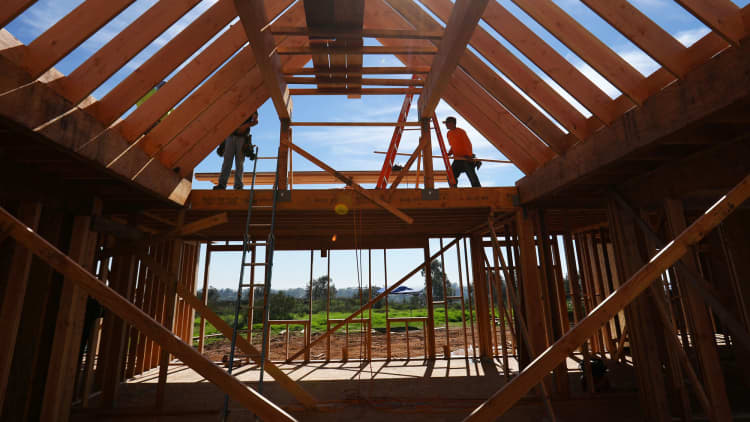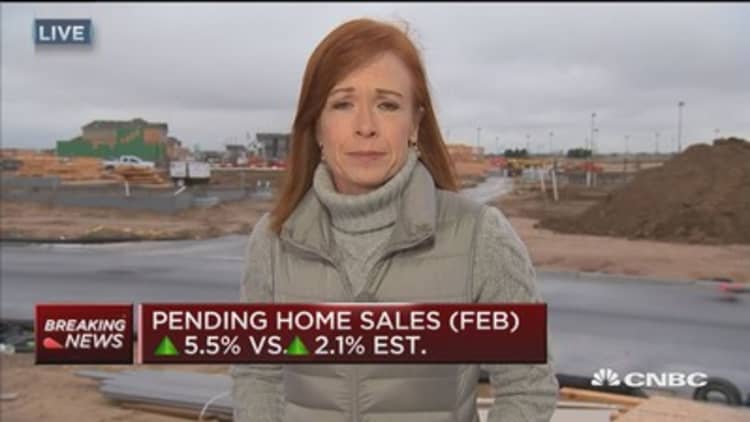
At a sprawling construction site barely 15 minutes from downtown Denver, workers move ground, pour foundations and frame walls and windows, but the work goes slowly because of the slim workforce.
Homes here take about two months longer than normal to build, and, in some cases, contractors are doubling their wages just to keep workers from skipping to the next site.
That's the backdrop as potential homebuyers in the mile-high city pile up and the supply of homes for sale continues to fall. Fierce competition pushes home prices higher at one of the fastest rates of any local market in the nation.
Housing industry veteran Gene Myers says he could be adding 50 percent more homes if he just had the people to build them. After weathering more than one recession, not to mention the worst housing crash in history, Myers says he has never seen anything like this.
"Especially the fact that it seems like we're at capacity at such a low level of actual absorption [sales]," said Myers, CEO of Thrive Home Builders, a midsized, privately owned builder in Denver. "In previous recessions, when we've recovered, we tend to see prices go up and labor starting to get tight after we've recovered to at least an average absorption."
He noted that Denver's average sales rate would normally be about 15,000 homes per year, and the market is now operating at just over half that rate. "We're feeling so much stress on the capacity of the industry."
Denver housing starts in 2016 were 22 percent higher than in 2015, but production is still historically low since the housing crash. Homes with base prices above $400,000 now represent 68 percent of the market, and homes priced above $500,000 represent 27 percent, according to Metrostudy, a housing analytics company. Both all-time highs are being fueled by steady demand from move-up buyers coupled with the rising costs of land, labor and materials.
Thousands of construction workers left the industry during the recession, many of them heading to the energy sector. The assumption was that they would return when energy lagged and homebuilding recovered. They did not. The labor shortage in building actually worsened in 2016 — a surprise to most analysts.
"We thought we'd see a flow back of workers from the energy sector," said Rob Dietz, chief economist with the National Association of Home Builders. "The labor shortage has basically grown and accelerated. It's the top challenge in the building industry right now."
Dietz points to both an immigration and a generational challenge. The workforce is aging, with the typical age of a construction worker now 42. More Americans are going to college now, and so they are less likely to pursue a career in construction. Simply put, young Americans don't want to build houses anymore. That leaves the business to immigrant laborers.
"These jobs, Americans don't want," Myers said. "We have a hard-working Hispanic labor force here in Denver that really is the foundation for the construction industry."
Immigrants make up about a quarter of the overall construction workforce, but that share is likely higher for residential homebuilding, partly due to a large number of undocumented workers. Builders say they make sure their contractors are legal to work, but they have less control over the subcontractors who often move from site to site. Even that group is shrinking, as President Donald Trump tries to impose travel bans and threatens to build a wall between the U.S. and Mexico.
"There is a fear to get out into the labor force, I think there is an uncertainty," Myers said. "I had one of our trades who became a citizen last year ask me if that could be taken away from him. Even for the people who are legal and documented, it's a factor that is holding back the labor force."
And it's costing builders more money. Wages in the residential building industry are growing at twice the rate of wages in the overall economy. Labor is the top concern among the nation's builders, according to an NAHB survey, and worry over its cost and availability is growing.
"Because the building industry is highly decentralized — there are 40,000 homebuilding companies in the country — you do see poaching. There are situations where you can recruit a worker, and they can work for you for a quarter or two, and then they're working for another subcontractor down the road," Dietz said.
Myers says he tries to build relationships with subcontractors. He has one-on-one meetings to build brand loyalty, but he admits, it often comes down to cold, hard cash. Some builders will spray paint a piece of plywood offering higher wages and drive it by a competitor's site.
"The crews, we would hope, would be loyal to subcontractors and to builders, but in reality, many of the crews are just going to the highest bidder," he said.
Myers has employed Juan, a Mexican immigrant, for more than a decade as an excavator. Juan, who didn't want to give his last name, said he became a citizen in 1999, and last year he and his brother-in-law started their own excavation company. Juan said some of his friends in Denver are buying property back in Mexico and planning to move back there. He worries about his own future and even deportation.
"I don't know what to think anymore with all these laws changing," he said.
Watch: Home production levels down, help wanted



